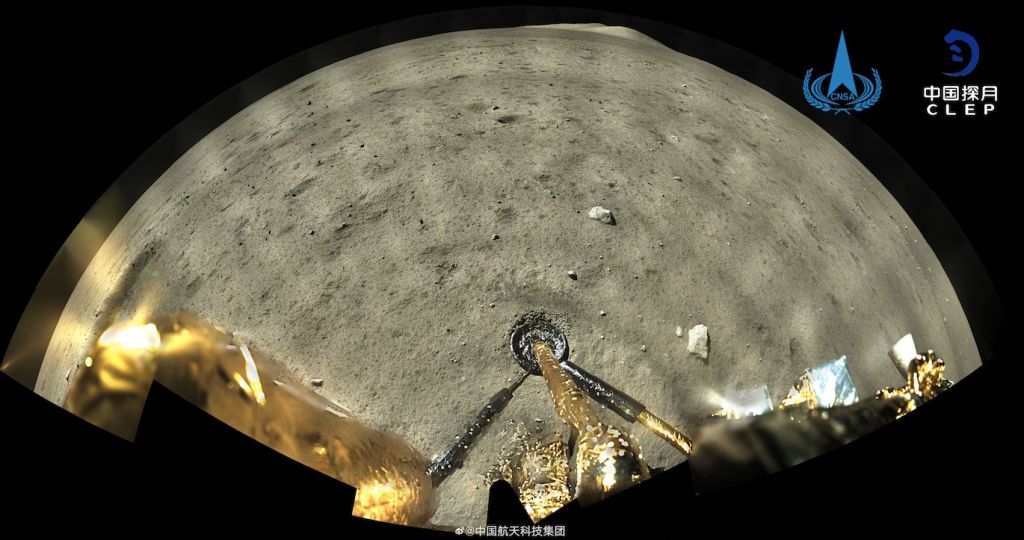China's missions to the moon and Mars are starting to deliver exciting science results
Tianwen 1 and Chang'e 5 represent a new era for China's space program.

A pair of daring Chinese missions launched in 2020 is sparking new and broader interest in planetary science in China.
The Tianwen 1 orbiter and rover mission, which launched for Mars in July 2020, and Chang'e 5, which gathered the youngest lunar samples ever collected and delivered them to Earth later that year, are now delivering exciting science results. The new data and results emerging from the missions sparked a call for a special session at this year's Lunar and Planetary Science Conference (LPSC), held in Texas and virtually beginning March 7.
For example, samples of the 3.81 pounds (1.73 kilograms) of lunar regolith and rocks collected by Chang'e 5 have been made available for applications for science institutes and universities, and new insights are already emerging.
Related: Watch China's Chang'e 5 spacecraft land on the moon in this amazing video
The Chang'e 5 mission has opened a new era of China's lunar and planetary sciences, Yuqi Qian, a doctoral candidate at the School of Earth Sciences at the China University of Geosciences in Wuhan and an author of papers presented at LPSC, told Space.com. "We have dozens of universities and institutes affiliated to the Chinese Academy of Sciences that have started to work on planetary sciences, with many new faces," Qian said.
Teams at LPSC presented papers on a range of topics, including lunar petrology, the study of rocks and the conditions under which they form; textual analysis of samples; and assessments of the geological context of the landing area.
A paper authored jointly by American, Chinese and European scientists notes how dating these relatively young Chang'e 5 samples, which are around 2 billion years old, allows for a refinement of the estimated ages of planetary surfaces in the solar system through counting the numbers of craters in particular areas. Areas with fewer craters are thought to be younger than those with more dense cratering, having had less time to be impacted by meteorites. Getting hold of samples and confirming the age of rocks through radioisotopic dating means scientists can verify and calibrate this technique.
Get the Space.com Newsletter
Breaking space news, the latest updates on rocket launches, skywatching events and more!
The new, young Chang'e 5 samples fill gaps left from estimates built on the Apollo samples, which are older than 3 billion years.
The presence of material associated with the lunar highlands was found in the Chang'e 5 rocks, which were collected from Oceanus Procellarum, the largest lunar mare, or dark plain. Other presentations described unusually high water content at the landing site, suggesting the rocks in the area originated from the lunar interior.
In addition to having a new presence at LPSC, China held its first planetary science conference last year and will have the second one this year.
China's first interplanetary mission, Tianwen 1, which includes the Zhurong rover in the plain of Utopia Planitia, is also exciting the science community.
Scientists from universitiesHong Kong and institutes in Wuhan and Weihai on the mainland noted that, unlike Mars' cold and oxidized surface, the subsurface of the Red Planet could provide the energy and liquid for past — or even present — life, making it an environment to search for biosignatures and evidence of life. Their paper focuses on mud volcanoes, which on Earth can expel subsurface materials from several miles deep and contain significant organic materials. Similar features on Mars in the vicinity of Zhurong could provide unique access to deep sediments, the scientists said.

The rover — with its terrain camera, multispectral cameras and surface composition detector — can collect mineralogy and chemical data, while the ground-penetrating radar can peer up to around 330 feet (100 meters) below the surface. Zhurong could, therefore, provide fascinating new insight into what lies beneath the surface of Mars, the researchers said.
Zhurong landed in Utopia Planitia in May 2021, and as of early February, the rover had driven a total of 5,043 feet (1,537 m). Tianwen 1 had been focused on relaying data from the rover to Earth until changing its orbit in November 2021 to begin its own dedicated science objectives.
Currently, data from the Tianwen 1 mission are accessible only to Chinese scientists, but the data will soon be made available internationally via China's Lunar and Planetary Data Release System.
Follow us on Twitter @Spacedotcom and on Facebook.
Join our Space Forums to keep talking space on the latest missions, night sky and more! And if you have a news tip, correction or comment, let us know at: community@space.com.

Andrew is a freelance space journalist with a focus on reporting on China's rapidly growing space sector. He began writing for Space.com in 2019 and writes for SpaceNews, IEEE Spectrum, National Geographic, Sky & Telescope, New Scientist and others. Andrew first caught the space bug when, as a youngster, he saw Voyager images of other worlds in our solar system for the first time. Away from space, Andrew enjoys trail running in the forests of Finland. You can follow him on Twitter @AJ_FI.










